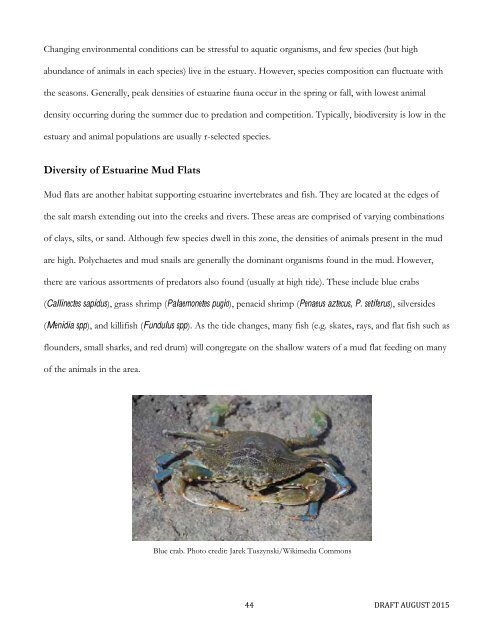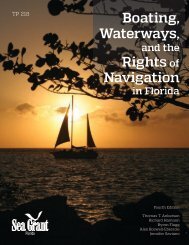Adopt-A-Wetland
XQDrg
XQDrg
Create successful ePaper yourself
Turn your PDF publications into a flip-book with our unique Google optimized e-Paper software.
Changing environmental conditions can be stressful to aquatic organisms, and few species (but high<br />
abundance of animals in each species) live in the estuary. However, species composition can fluctuate with<br />
the seasons. Generally, peak densities of estuarine fauna occur in the spring or fall, with lowest animal<br />
density occurring during the summer due to predation and competition. Typically, biodiversity is low in the<br />
estuary and animal populations are usually r-selected species.<br />
Diversity of Estuarine Mud Flats<br />
Mud flats are another habitat supporting estuarine invertebrates and fish. They are located at the edges of<br />
the salt marsh extending out into the creeks and rivers. These areas are comprised of varying combinations<br />
of clays, silts, or sand. Although few species dwell in this zone, the densities of animals present in the mud<br />
are high. Polychaetes and mud snails are generally the dominant organisms found in the mud. However,<br />
there are various assortments of predators also found (usually at high tide). These include blue crabs<br />
(Callinectes sapidus), grass shrimp (Palaemonetes pugio), penaeid shrimp (Penaeus aztecus, P. setiferus), silversides<br />
(Menidia spp), and killifish (Fundulus spp). As the tide changes, many fish (e.g. skates, rays, and flat fish such as<br />
flounders, small sharks, and red drum) will congregate on the shallow waters of a mud flat feeding on many<br />
of the animals in the area.<br />
Blue crab. Photo credit: Jarek Tuszynski/Wikimedia Commons<br />
44 DRAFT AUGUST 2015



